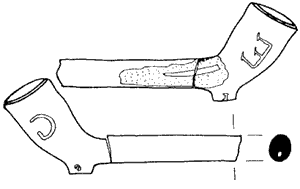No. 13/2000, p. 54-82
Alice Kaltenberger: Clay pipes from Kniepass Castle in the Unken
district, near Lofer, Salzburg
The finds from the castle on the Kniepass pass near Unken represent
the first large suite of pipes from Austria to be described in scientific
literature. Most of the pipes are heeled but a few are round-bottomed,
i.e. heelless. Most of them have a double-conical shape, characteristic
of the second half of the 17th century. Later in the 17th century
the pipes became larger and the bowl was more oblique to the stem.
A relatively large proportion of the pipes are glazed, not unsually
for pipes of the 17th century. Some pipes have a plain colour glaze
as well as a spatter pattern, which is known to have been a characteristic
type of pattern on ceramic ware from Oberösterreich, Salzburg
and SE Bavaria and is reminiscent of secondary glaze in local workshops.
Only two marked pipe bowls with heels and two stems possess a fine,
pale coloured, well polished surface, a fact that could well indicate
that they originate from Holland. The pipes were obviously valued
considerably by the soldiers stationed at the castle; this is demonstrated
by various repairs on some pipes, including a metal sleeve to reconnect
two fragments of a stem. Find complexes with similar composition
and similar objects have been described from Freiburg, Breisach,
Konstanz and Passau.
|

Pipe with heel, bowl shows two large letters in relief
(E and G), German, around 1680/90
|
